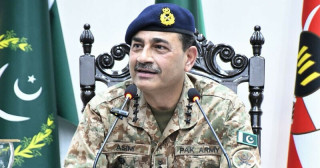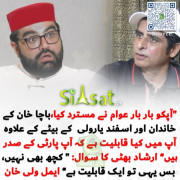KhanHaripur
Chief Minister (5k+ posts)

This image shows what was right and wrong about the Pakistani-American alliance over the past century.
AHMED QURAISHI | Wednesday | 27 April 2011 | Photo Courtesy Col. Riaz Jafri
ISLAMABAD, PakistanWithout a question, this image shows how warm were ties between Pakistan and the United States in the 1950s and 1960s. This was a time when Pakistan voluntarily joined the US camp against Soviet Union and committed itself to offer military support to weaker pro-US regimes in the Middle East.
At considerable risk to itself, Islamabad even allowed American spy planes to fly from an airbase near Peshawar in northwest Pakistan. The Soviets downed one of them, exposing Pakistani complicity in an unprovoked act of aggression against a neighbor. A senior Soviet leader at the time warned to wipe Pakistan off of the face of the earth.
During these years, the international dispute over Kashmir was a hot topic at the United Nations. The Indians were the first to take the matter to the UN and hence were committed to respecting Kashmiri peoples demand to decide their future under a fair and free plebiscite arranged by the UN. All that India needed to do the right thing was a little nudge from powerful countries, like the United Kingdon and the United States.
For risking their strategic position, the Pakistanis expected its allies in the Cold War like the US and UK to help resolve Kashmir, if not outrightly side with Pakistan in the dispute.
Astonishingly, both the US and UK betrayed Pakistan. Right from the start, Washington and its major allies treated Pakistan with contempt and deceit. In 1962, and even though India was a staunch Soviet ally, the United States rushed militry supplies to India as it was beaten out of a piece of border land by the Chinese army.
Only three years later, Washington refused to help Pakistan in a war with a country several times larger over the disputed region of Kashmir. By then, India reneged on its UN commitments and forcibly annexed Kashmir.
Six years later, the United States violated the very defense pacts that it had Pakistan sign a few years earlier when India launched an unprovoked invasion of Pakistan across international boundaries. It was December 1971. The Indians exploited heated post-election bickering in Pakistan and saw an opportunity to invade East Pakistan. To the surprise of Pakistanis, the invading Indian army was joined by a proxy militia that India recruited and trained for over two years and kept it under wraps as a sleeper cell to be activated only when India invaded. Faced with naked and unprovoked aggression, Pakistanis waited for their American ally to take a stand. The Americans never came.
President Ayub Khan, seen in this picture, recognized fairly quickly the two-faced nature of US foreign policy and its commitments to its allies. Just before he stepped down from power, he wrote a fascinating book, Friends Not Masters. In it he reminded the Americans that Pakistan can be a friend but not a proxy or a satellite. His lesson to his own people was not heeded by future Pakistani leaders.
The biggest blunder came under the reign of Presidnet Pervez Musharraf, who used to proudly tell his close friends after 2002 that he has established Pak-US relations on solid grounds and this time they wont betray us.
What happened between 2002 and 2010 was a repeat of the larger history of Pak-US bilateral relations. Right from day one, the Americans turned Afghanistan into an anti-Pakistan territory, invited India to set up intelligence presence and hound Pakistan, and created conditions for insurgencies across western Pakistan that feed on the US-controlled Afghan sanctuary. All while US officials paid lip service to relations with Pakistan, calling it a Major Non-NATO Ally. Oh, yes, the aid. Some $10 billion, half of them compensation for using Pakistani military facilities. Contrast that with over $60 billion dollars until the end of 2010 in direct and indirect losses to the Pakistani economy since 2002. [According to the latest estimates by analysts at the federal Ministry of Finance, this figure has reached $80 billiob by April 2011].
This photograph reveals one key aspect of the Pak-US relationship over the years. Its the exaggerated trust that Pakistani leaders have placed in US officials and policies. See how casual and warm President Khan is here with President Johnson, who appears to be a little reticent.
US policy has often relied on personal relationships in Pakistan, both with politicians and military officers. And almost every time, history repeats itself, when one more Pakistani leader is convinced that the Americans have a differnet kind of relationship with him than his predecessors, and then he starts giving Washington policy concessions at the expense of the iterests of Pakistani people, only to discover too late that you can befriend Washington, but you cant rely on it.
2007-2011. All rights reserved. Paknationalists.com
Verbatim copying and distribution of this entire article is permitted in any medium
without royalty provided this notice is preserved.
Verbatim copying and distribution of this entire article is permitted in any medium
without royalty provided this notice is preserved.


























